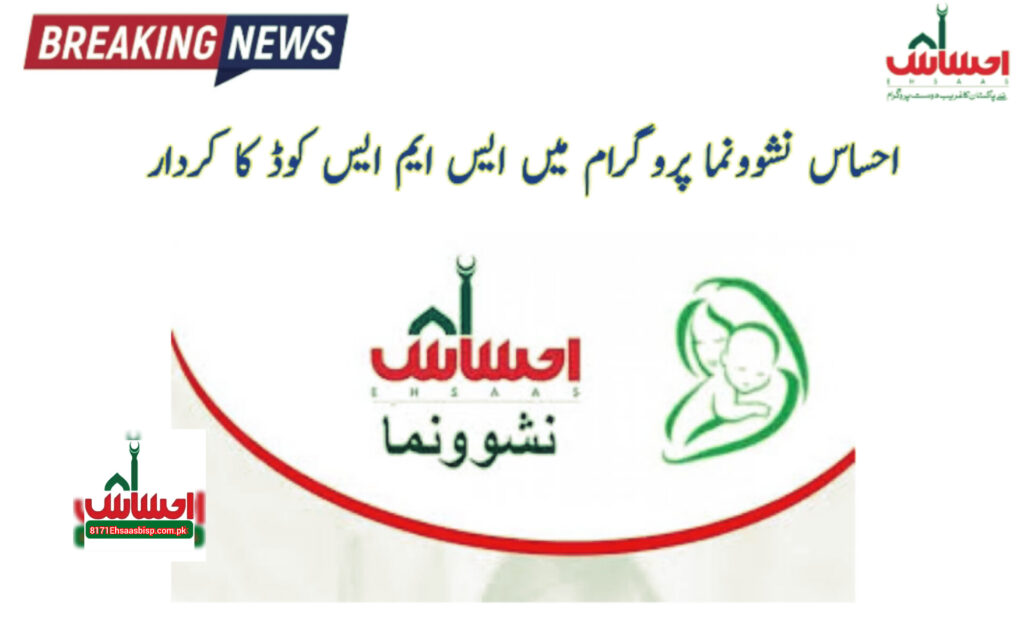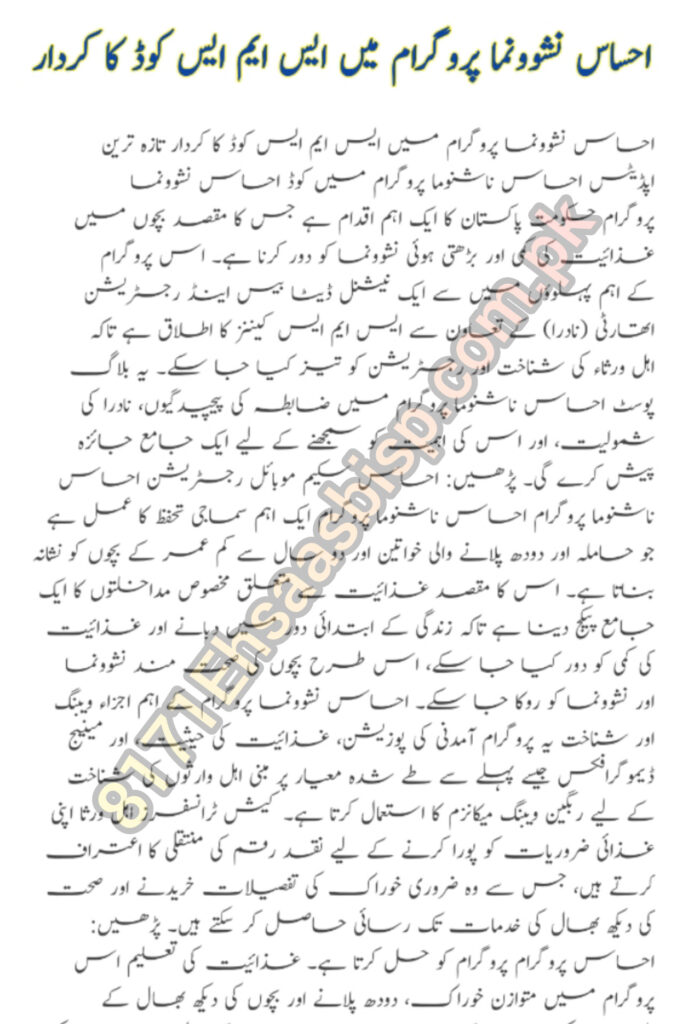
Code in Ehsaas Nashonuma Program
The Ehsaas Nashonuma Program is a crucial initiative by the Government of Pakistan aimed at combating malnutrition and stunted growth among children. A significant component of this program is the use of SMS codes in collaboration with the National Database and Registration Authority (NADRA) to facilitate the identification and registration of eligible beneficiaries. This blog post delves into the complexities of the Code in the Ehsaas Nashonuma Program, NADRA’s involvement, and provides a comprehensive overview of its significance.
The Ehsaas Nashonuma Program
The Ehsaas Nashonuma Program is a flagship social protection initiative targeting pregnant and lactating women and children under the age of two. It aims to provide a comprehensive package of nutrition-specific interventions to address stunting and malnutrition in the early years of life, ensuring healthy growth and development of children.
Key Components of the Ehsaas Nashonuma Program
Screening and Identification

The program employs various screening mechanisms to identify eligible beneficiaries based on predefined criteria such as income level, nutritional status, and household demographics.
Cash Transfers
Eligible beneficiaries receive cash transfers to support their nutritional needs, enabling them to purchase essential food items and access healthcare services.
Nutrition Education
The program includes nutrition education and counseling sessions to raise awareness about the importance of a balanced diet, breastfeeding, and child care practices.
Growth Monitoring
Regular growth monitoring and evaluation are conducted to track the progress of enrolled children and ensure timely interventions if any growth faltering is detected.
See Also:
- Breaking News: How to Apply for the Agriculture Internship Program: A Detailed Guide 2024
- Exclusive Updates: Punjab Government Announces Major Recruitment Drive for 30,000 Teachers 2024
- Breaking News: Sindh Textbook Board Launches Ambitious Tablet Distribution Initiative for Students 2024
- ASF Jobs Apply Before August 25, 2024 – Complete Guide
- Exclusive News: Huawei Train the Trainer Program: A Groundbreaking Initiative for Pakistani Students in 2024
Role of SMS Code in Ehsaas Nashonuma Program
The SMS code plays a pivotal role in the registration and management of beneficiaries in the Ehsaas Nashonuma Program. Beneficiaries are required to send a designated SMS code to a specified number to register for the program. This SMS code serves as a unique identifier and allows seamless communication and coordination between the program administrators and the beneficiaries.
Involvement of NADRA
NADRA, the national authority responsible for maintaining the citizens’ database, collaborates with the Ehsaas Nashonuma Program to verify the identity and eligibility of beneficiaries. Through its robust infrastructure and technological capabilities, NADRA ensures the authenticity of beneficiary information and streamlines the registration process.
Quick Information
| SMS Code | Description |
|---|---|
| EHP123 | Enrollment for Pregnant Women |
| EHC456 | Enrollment for Children (0-2 years) |
| NED789 | Nutrition Education Sessions |
Final Thoughts
The Ehsaas Nashonuma Program represents a significant step towards addressing malnutrition and stunted growth in Pakistan. By leveraging SMS codes and partnering with NADRA, the program aims to effectively reach vulnerable populations and deliver targeted interventions to improve nutrition outcomes among mothers and children. Continued investment in infrastructure, outreach, and monitoring mechanisms is essential to ensure the program’s success and sustainability in the long run.
FAQs
Q1: How can I register for the Ehsaas Nashonuma Program?
Eligible beneficiaries can send the designated SMS code corresponding to their category (e.g., pregnant women, children under 2 years) to the specified number provided by the program administrators.
Q2: What documents are needed for registration in the program?
The specific documentation requirements may vary, but generally, beneficiaries may need to provide proof of identity, residence, and income status to qualify for the program.
Q3: How are cash transfers distributed to beneficiaries?
Cash transfers are typically disbursed through mobile banking or designated payment centers, ensuring secure and accessible access for beneficiaries.
Q4: Is the Ehsaas Nashonuma Program available nationwide?
While the program aims to expand its coverage across the country, implementation may vary by region, with priority given to areas with higher rates of malnutrition and poverty.
Q5: How does the program ensure the effectiveness of nutrition interventions?
The program incorporates regular monitoring and evaluation mechanisms to assess the impact of nutrition interventions on beneficiary outcomes, enabling adaptations and improvements as needed.
Conclusion
The Ehsaas Nashonuma Program underscores the government’s commitment to improving the nutritional status and well-being of vulnerable populations in Pakistan. Through strategic partnerships, innovative approaches, and a focus on evidence-based interventions, the program has the potential to make a meaningful difference in the lives of millions of mothers and children, laying the foundation for a healthier and more prosperous future.
